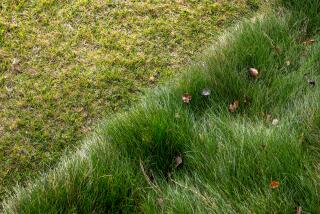Tomatoes Rotting? The Only Cure Is Prevention
- Share via
QUESTION: What could be causing the black, rotten areas on the bottoms of my tomatoes?
--L.W., Santa Monica
ANSWER: Brown-black blotches on the blossom end of green or red tomatoes are a physiological disease (not caused by microorganisms) called blossom end rot, according to the U.C. Extension publication, “Pests of the Garden and Small Farm.”
They are caused by a lack of calcium, but adding calcium does not help because blossom end rot is caused by salts in the soil or erratic watering. It is more common on sandier soils, so I suspect you live on one of the ancient sand dunes in the Ocean Park area.
The cure is prevention. There’s no fixing fruit that is already affected, but you can prevent blossom end rot by trying to maintain what they call “even soil moisture,” which means that you don’t let the plant get real wet and then let it go dry before watering again. A mulch will dramatically help smooth things out, especially a clear plastic one that also warms the soil, which tomatoes like near the beach. If this doesn’t do the trick, try another tomato variety because some are more susceptible than others.
Drip Irrigation Works Best in Hillsides
Q: What’s the best way to water a small but heavily planted hillside? Right now I’m doing the whole thing by hand, although I found one old Rainbird sprinkler in a corner that no longer works.
--C.Z., Silver Lake
A: That old pulsating sprinkler is certainly the easiest way to water a hillside, but look for the newer “low-gallonage” versions that put water on slowly so it soaks in and doesn’t run down the hill. You can space some up to 50 feet apart, so one in each corner of the hillside should cover the field. Put them on top of tall, staked risers (pipes) so they spray above the shrubbery and water when there’s no wind.
The best way to irrigate a hillside is with drip because there is no runoff, but be sure to use “pressure-compensating” emitters to even out the flow between the top of the hill and the bottom. Expert Robert Kourik suggests laying out parallel lines “that look like sheet music,” with a single supply line going up one side of the yard. He prefers “in-line” emitters that are built into the tubing. On heavy soils, space the emitters up to 24 inches apart; on sandy soils, they must be 12 inches apart. His book, “Drip Irrigation” (Metamorphic Press, Santa Rosa, (707) 874-2606) can tell you all about buying and installing a drip system.
Making the Most of a Steeply Sloping Yard
Q: We recently bought a house with a steeply sloped back yard. The previous owners had planted a lawn, and part of the hill, with Bermuda grass. The rest of the hill is wild grasses. We are eager to replant the hill in drought-resistant plant that will stabilize the hillside and attract birds and butterflies, but how do we get rid of the Bermuda grass without killing all the earthworms, and what can we plant? After watching hillsides all over California slide during the storms of the last year, we feel like we need something stronger than grass holding onto the hill.
--P.G., Kagel Canyon
A: Getting rid of the Bermuda grass is easy using glyphosate (one brand is called Round-up), and this herbicide has a very good environmental record, breaking down as soon as it hits the soil. It is taken into the plant through the leaves and carried to the Bermuda’s underground runners. Carefully read the label directions and you’ll find that it works best during hot weather, so now is the time to apply it. Be sure to keep the spray off anything you want to keep.
You can dig out all those underground runners by hand, but that is a herculean job.
Fall is the best time to plant a hillside, so you can plant as soon as you’re sure the Bermuda is dead, though you may want to water thoroughly to bring up all the weed seeds undoubtedly lying on the hillside, then hoe them out.
Roots certainly help hold a hillside together, but it’s more important to keep the hillside from getting saturated, so drought resistant plants are a good choice, but make sure you have some way of watering them the first few years (see the question below).
Many plants do well on hillsides, and a good source of information and native plants is near your house: the Theodore Payne Foundation in Sun Valley. People there will also be able to suggest plants that birds and butterflies like.
Here are a few that resist drought and are less flammable (nothing is fireproof). Birds will like the native hollyleaf redberry (Rhamnus crocea illicifolia) and toyon, proven hill-holders, as is the non-native lantana, especially L. montevidensis, loved by hummingbirds and butterflies. The larva of the little metallic butterflies called blues like California buckwheat (Erigonum fasiculatum) and dwarf coyote brush, medium-tall hill-holding ground covers. Native ceanothus get quite wide (or tall, depending on the kind), but they’re another favorite of larva and birds. Ground-covering rosemary and Coprosma kirkii are also good hill-binders.
The more variety you plant, the prettier the hillside will be and the less likely you will be to have problems down the road. Plant in little basins carved out of the hillside.
Questions should be sent to “Garden Q&A;” in care of the Real Estate section, Los Angeles Times, Times Mirror Square, Los Angeles 90053. Questions cannot be answered individually.






